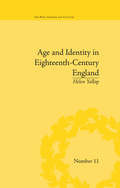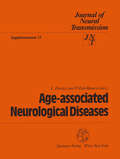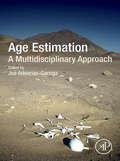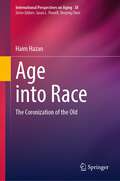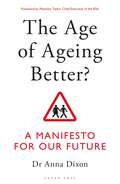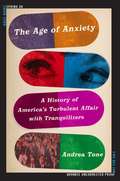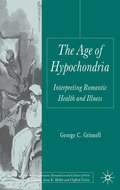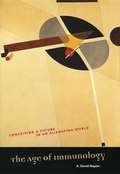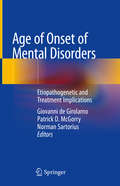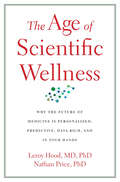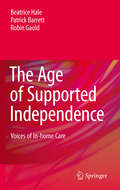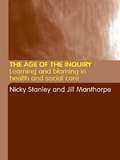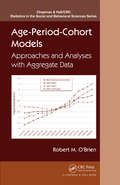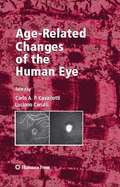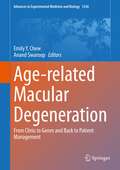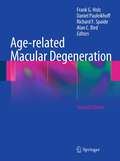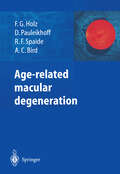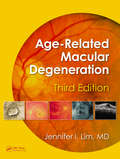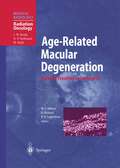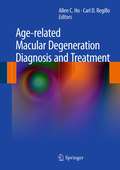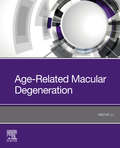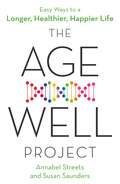- Table View
- List View
Age and Identity in Eighteenth-Century England ("The Body, Gender and Culture" #11)
by Helen YallopYallop looks at how people in eighteenth-century England understood and dealt with growing older. Though no word for ‘aging’ existed at this time, a person’s age was a significant aspect of their identity.
Age-associated Neurological Diseases (Journal of Neural Transmission. Supplementa #33)
by PeterDal-Bianco LüderDeeckeThe papers compiled in this supplementum are a selection of the best con th tributions presented at the 19 Central-European Neurological Symposium (CNS 19) held on June 29 - July 1, 1989 in Vienna. The main topic of this conference was degenerative and age-associated neurological diseases. In recent decades life expectancy has dramatically increased, at least in the industrialized countries. This has led to extreme distortions of the so-called population pyramids that no longer look like such but begin to almost resemble cylinders. As a consequence of this "overaging" of the population, diseases that are associated with age have become much more common than before. It was thus more than reasonable to devote a congress of the CNS series to these important neurological diseases. The following fields of interest are covered: Age-associated memory impairment (AAMI), Alzheimer's and other dementias, Parkinson's disease and other movement disorders, stroke and others. Concerning the de men tias, some papers deal with diagnosis employing neuro-imaging methods such as MRI, CT, PET and SPECT, others using electrophysiological methods. An important aspect in the early preclinical diagnosis of dementia is the inclusion of neuropsychological tests to enhance the chance of effec tive early treatment. Also drugs that are now under clinical investigation are discussed and preliminary results are presented.
Age Estimation: A Multidisciplinary Approach
by Joe Adserias-GarrigaAge Estimation: A Multidisciplinary Approach is the only reference in the field covering all techniques and methods involving age estimation from different perspectives in just one volume. The book provides comprehensive coverage of all aspects of age estimation: aging the living and the dead, human rights, and skeletal, dental, histological and biochemical techniques and methods available. Each chapter is written by internationally known expert contributors. Age Estimation: A Multidisciplinary Approach is a one of a kind resource for those involved in estimating the age of the living and the dead.Presents a concentration of all techniques and methods involving age estimation in a single volumeProvides a multidisciplinary approach that lends itself to researchers, practitioners and students from a variety of different fieldsIncludes contributions by world renowned forensic specialists
Age into Race: The Coronization of the Old (International Perspectives on Aging #38)
by Haim HazanAge into Race is a socio-anthropological essay on the repercussions of the Covid-19 pandemic on the cultural status of the old. As the worldwide horrors of the Corona era have since been publicly repressed, the text is geared to revisit and relive the tenor of that time while considering its latent revolutionary aftermath. There was wide agreement that Covid-19 policies targeted older people as a risk group in need of protection, setting it apart from the rest of society. Yet, paradoxically, long-term facilities for older people effectively became Covid-19 death traps. What kind of abandonment propelled this apparent contradiction? This book provides an answer by looking at ageist practices regarding Covid-19 triaging, lockdowns and distancing that affected older people around the world, devising Covid-19 as an inevitable "problem of the elderly" and, by implication, instating and categorizing "the elderly" as a public problem to be bio-politically managed and wrought. The Covid-19 pandemic and its concomitant "state of emergency" triggered an accelerated transmutation of customary ageism into emergent racism, spelling a fatal switch to designating the old as bearers of "bare" life unworthy of human living, thus turning old age from a seemingly cultural category to a socially fabricated viral menace of nature. The book tracks down the process through which the "Coronization" of culture legitimized and impelled a further stigmatization of old age beyond mere ageism to sheer racism. Thus, this transmutation, while compromising their autonomy and subjectivity via imposed lockdowns, social isolation, excommunication and selective discrimination rendered the old a race apart. Subsequently, the moral panic invoked by the specter of the pandemic transformed the social perceptions of later life from a containable social problem to an unbridled public hazard that summoned total measures presented as bureaucratically regimented regulations that dehumanized its victims with impunity.
The Age of Ageing Better?: A Manifesto For Our Future
by Anna Dixon'Dr Anna Dixon has written a must-read for anyone interested in the future of ageing. Learn from one of the best informed about an issue, and opportunity, that is facing us all.'Andy Briggs, Head of FTSE 100 life insurer Phoenix Group'A very important book'Sir Muir GrayThe Age of Ageing Better? takes a radically different view of what our ageing society means. Dr Anna Dixon turns the misleading and depressing narrative of burden and massive extra cost of people living longer on its head and shows how our society could thrive if we started thinking differently. This book shines a spotlight on how as a society we're currently failing to respond to the shifting age profile – and what needs to change. Examining key areas of society including health, financial security, where and how people live, and social connections, Anna Dixon presents a refreshingly optimistic vision for the future that could change the way we value later life in every sense.
The Age of Ageing Better?: A Manifesto For Our Future
by Anna Dixon'Dr Anna Dixon has written a must-read for anyone interested in the future of ageing. Learn from one of the best informed about an issue, and opportunity, that is facing us all.'Andy Briggs, Head of FTSE 100 life insurer Phoenix Group'A very important book'Sir Muir GrayThe Age of Ageing Better? takes a radically different view of what our ageing society means. Dr Anna Dixon turns the misleading and depressing narrative of burden and massive extra cost of people living longer on its head and shows how our society could thrive if we started thinking differently. This book shines a spotlight on how as a society we're currently failing to respond to the shifting age profile – and what needs to change. Examining key areas of society including health, financial security, where and how people live, and social connections, Anna Dixon presents a refreshingly optimistic vision for the future that could change the way we value later life in every sense.
The Age of Anxiety: A History of America's Turbulent Affair with Tranquilizers
by Andrea ToneAnxious Americans have increasingly pursued peace of mind through pills and prescriptions. In 2006, the National Institute of Mental Health estimated that 40 million adult Americans suffer from an anxiety disorder in any given year: more than double the number thought to have such a disorder in 2001. Anti-anxiety drugs are a billion-dollar business. Yet as recently as 1955, when the first tranquilizer-Miltown-went on the market, pharmaceutical executives worried that there wouldn't be interest in anxiety-relief. At mid-century, talk therapy remained the treatment of choice. But Miltown became a sensation-the first psychotropic blockbuster in United States history. By 1957, Americans had filled 36 million prescriptions. Patients seeking made-to-order tranquility emptied drugstores, forcing pharmacists to post signs reading "more Miltown tomorrow.” The drug's financial success and cultural impact revolutionized perceptions of anxiety and its treatment, inspiring the development of other lifestyle drugs including Valium and Prozac. In The Age of Anxiety, Andrea Tone draws on a broad array of original sources-manufacturers' files, FDA reports, letters, government investigations, and interviews with inventors, physicians, patients, and activists-to provide the first comprehensive account of the rise of America's tranquilizer culture. She transports readers from the bomb shelters of the Cold War to the scientific optimism of the Baby Boomers, to the "just say no” Puritanism of the late 1970s and 1980s. A vibrant history of America's long and turbulent affair with tranquilizers, The Age of Anxiety casts new light on what it has meant to seek synthetic solutions to everyday angst.
The Age of Hypochondria: Interpreting Romantic Health and Illness (Palgrave Studies in the Enlightenment, Romanticism and Cultures of Print)
by G. GrinnellExamining the ways in which hypochondria forms both a malady and a metaphor for a range of British Romantic writers, Grinnell contends that this is not one illness amongst many, but a disorder of the very ability to distinguish between illness and health, a malady of interpretation that mediates a broad spectrum of pressing cultural questions.
The Age of Immunology: Conceiving a Future in an Alienating World
by A. David NapierIn this fascinating and inventive work, A. David Napier argues that the central assumption of immunology—that we survive through the recognition and elimination of non-self—has become a defining concept of the modern age. Tracing this immunological understanding of self and other through an incredibly diverse array of venues, from medical research to legal and military strategies and the electronic revolution, Napier shows how this defensive way of looking at the world not only destroys diversity but also eliminates the possibility of truly engaging difference, thereby impoverishing our culture and foreclosing tremendous opportunities for personal growth. To illustrate these destructive consequences, Napier likens the current craze for embracing diversity and the use of politically correct speech to a cultural potluck to which we each bring different dishes, but at which no one can eat unless they abide by the same rules. Similarly, loaning money to developing nations serves as a tool both to make the peoples in those nations more like us and to maintain them in the nonthreatening status of distant dependents. To break free of the resulting downward spiral of homogenization and self-focus, Napier suggests that we instead adopt a new defining concept based on embryology, in which development and self-growth take place through a process of incorporation and transformation. In this effort he suggests that we have much to learn from non-Western peoples, such as the Balinese, whose ritual practices require them to take on the considerable risk of injecting into their selves the potential dangers of otherness—and in so doing ultimately strengthen themselves as well as their society. The Age of Immunology, with its combination of philosophy, history, and cultural inquiry, will be seen as a manifesto for a new age and a new way of thinking about the world and our place in it.
The Age of Immunology: Conceiving a Future in an Alienating World (Morality And Society Ser.)
by A. David NapierIn this fascinating and inventive work, A. David Napier argues that the central assumption of immunology—that we survive through the recognition and elimination of non-self—has become a defining concept of the modern age. Tracing this immunological understanding of self and other through an incredibly diverse array of venues, from medical research to legal and military strategies and the electronic revolution, Napier shows how this defensive way of looking at the world not only destroys diversity but also eliminates the possibility of truly engaging difference, thereby impoverishing our culture and foreclosing tremendous opportunities for personal growth. To illustrate these destructive consequences, Napier likens the current craze for embracing diversity and the use of politically correct speech to a cultural potluck to which we each bring different dishes, but at which no one can eat unless they abide by the same rules. Similarly, loaning money to developing nations serves as a tool both to make the peoples in those nations more like us and to maintain them in the nonthreatening status of distant dependents. To break free of the resulting downward spiral of homogenization and self-focus, Napier suggests that we instead adopt a new defining concept based on embryology, in which development and self-growth take place through a process of incorporation and transformation. In this effort he suggests that we have much to learn from non-Western peoples, such as the Balinese, whose ritual practices require them to take on the considerable risk of injecting into their selves the potential dangers of otherness—and in so doing ultimately strengthen themselves as well as their society. The Age of Immunology, with its combination of philosophy, history, and cultural inquiry, will be seen as a manifesto for a new age and a new way of thinking about the world and our place in it.
Age of Onset of Mental Disorders: Etiopathogenetic and Treatment Implications
by Giovanni De Girolamo Patrick D. McGorry Norman SartoriusThis book presents a thorough and critical review of current knowledge about the age of onset of mental disorders. The opening chapters offer information about the impact of the age of onset on the clinical picture, course, and outcome of physical illnesses, and about the neurobiological implications and correlates of different ages of onset. The impact and correlates of the ages of onset of all the most important mental disorders are then discussed in detail by internationally renowned scientists. The background to the book is the recognition that a better understanding of age of onset makes it possible to estimate the lifetime risk of disorders, helps to elucidate pathogenesis, and facilitates efficient, targeted clinical management. The book will be of value for clinicians, mental health professionals, mental health researchers, epidemiologists, and different stakeholders in the mental health field.
The Age of Scientific Wellness: Why the Future of Medicine Is Personalized, Predictive, Data-Rich, and in Your Hands
by Leroy Hood Nathan PriceTaking us to the cutting edge of the new frontier of medicine, a visionary biotechnologist and a pathbreaking researcher show how we can optimize our health in ways that were previously unimaginable.We are on the cusp of a major transformation in healthcare—yet few people know it. At top hospitals and a few innovative health-tech startups, scientists are working closely with patients to dramatically extend their “healthspan”—the number of healthy years before disease sets in. In The Age of Scientific Wellness, two visionary leaders of this revolution in health take us on a thrilling journey to this new frontier of medicine.Today, most doctors wait for clinical symptoms to appear before they act, and the ten most commonly prescribed medications confer little or no benefit to most people taking them. Leroy Hood and Nathan Price argue that we must move beyond this reactive, hit-or-miss approach to usher in real precision health—a form of highly personalized care they call “scientific wellness.” Using information gleaned from our blood and genes and tapping into the data revolution made possible by AI, doctors can catch the onset of disease years before symptoms arise, revolutionizing prevention. Current applications have shown startling results: diabetes reversed, cancers eliminated, Alzheimer’s avoided, autoimmune conditions kept at bay.This is not a future fantasy: it is already happening, but only for a few patients and at high cost. It’s time to make this gold standard of care more widely available. Inspiring in its possibilities, radical in its conclusions, The Age of Scientific Wellness shares actionable insights to help you chart a course to a longer, healthier, and more fulfilling life.
The Age of Supported Independence: Voices of In-home Care
by Beatrice Hale Patrick Barrett Robin GauldThis book investigates the experiences of older people who remain at home with care. It examines the transition points for the important life changes faced by family members who take on a greater care-giving role. The book draws on demographic analyses and qualitative fieldwork to explore the shift from independence to increasing dependence, and suggests that this transition constitutes movement into a new stage of life, that of an Age of Supported Independence. Applying the anthropological concept of rites of passage in their analysis, the authors focus on the changes in everyday living within the spatial environment of the home, the temporal organization of daily life, and the reshaping of relationships. They suggest that many older people – as well as the family members who become carers – remain in a state of ‘liminality’: unable to make sense of their new situation and experience and, despite assumptions that ageing-in-place sustains social connectedness, excluded from their communities.
The Age of the Inquiry: Learning and Blaming in Health and Social Care
by Jill Manthorpe Nicky StanleyThe plethora of inquiry reports published in the fields of health and welfare in the 1990s covered the full range of user groups, individuals and institutions. What similarities or differences were there between these inquiries? How effective were they in bringing about change? Whose interest did they best serve?These are some of the questions The Age of the Inquiry explores in detail, bringing together distinguished contributors with personal experience of chairing or providing evidence to inquiries to consider: the participant's view of inquiriesthe purpose of inquiriesthe impact of inquiries on health and social policyinquiries into: child abuse and death; homicides by mental health service users; the abuse of adults with learning disabilities; the abuse of older people. Wide-ranging in scope, The Age of the Inquiry focuses on service and policy development. It provides an invaluable text for students, teachers and professionals from a wide range of disciplines and professional groups.
The Age of the Inquiry: Learning and Blaming in Health and Social Care
by Nicky Stanley Jill ManthorpeThe plethora of inquiry reports published in the fields of health and welfare in the 1990s covered the full range of user groups, individuals and institutions. What similarities or differences were there between these inquiries? How effective were they in bringing about change? Whose interest did they best serve?These are some of the questions The Age of the Inquiry explores in detail, bringing together distinguished contributors with personal experience of chairing or providing evidence to inquiries to consider: the participant's view of inquiriesthe purpose of inquiriesthe impact of inquiries on health and social policyinquiries into: child abuse and death; homicides by mental health service users; the abuse of adults with learning disabilities; the abuse of older people. Wide-ranging in scope, The Age of the Inquiry focuses on service and policy development. It provides an invaluable text for students, teachers and professionals from a wide range of disciplines and professional groups.
Age-Period-Cohort Models: Approaches and Analyses with Aggregate Data
by Robert O'BrienDevelop a Deep Understanding of the Statistical Issues of APC AnalysisAge-Period-Cohort Models: Approaches and Analyses with Aggregate Data presents an introduction to the problems and strategies for modeling age, period, and cohort (APC) effects for aggregate-level data. These strategies include constrained estimation, the use of age and/or period
Age-Related Changes of the Human Eye (Aging Medicine)
by Carlo A. P. Cavallotti Luciano CerulliAging research on the human eyes crosses all areas of ophthalmology and also relies upon biological, morphological, physiological, and biochemical tools for its study. This book reviews all aspects of human eye aging. In addition to descriptions of age-related changes in almost all the structures of the human eyes, the authors also include interesting accounts of personal experiments and data. It provides an extensive panorama of what happens during aging in the eye.
Age-related Macular Degeneration: From Clinic to Genes and Back to Patient Management (Advances in Experimental Medicine and Biology #1256)
by Emily Y. Chew Anand SwaroopThis edited book focuses on the recent advances in our understanding of age-related macular degeneration (AMD), combining epidemiology and clinical diagnosis, with genetics and immunological aspects as well as the role of proteostasis and mitochondria before diving into new therapies including stem cell based approaches. AMD is a leading cause of largely incurable blindness worldwide and projected to double from 2.07 million to 5.44 million individuals by 2050 in the United States. Globally, 288 million individuals are projected to have AMD by 2040. The disease has enormous socioeconomic impact on the affected individuals, their families and the society. This book will bring together the state of the art basic science knowledge with clinically relevant findings and address the challenges for future research in AMD. The intersection of different disciplines will provide potential areas for further investigations to reduce the burden of blindness from AMD. This book offers an appealing and insightful resource for clinicians, scientists, students and fellows.
Age-related Macular Degeneration
by Frank G. Holz, Daniel Pauleikhoff, Richard F. Spaide and Alan C. BirdAge-related macular degeneration is the most common cause for the loss of central vision beyond the age of 50 in industrial nations. Triplication of the number of affected patients is expected over the next 25 years. Especially over the last years the standard of knowledge regarding etiology, risk factors, diagnostics and therapy of this retina illness has substantially grown – this will be covered in this up-to-date multi-authored work. Apart from epidemiologically and genetically identified risk factors both the various pathophysiological aspects including the role of the complement system and clinical manifestations including OCT and angiographic characteristics are clearly represented. Furthermore, the different therapeutic approaches are presented and discussed, including proven procedures such as intravitreal anti-VEGF therapy and seeing-aid systems, in addition to the latest and upcoming methods in the area of pharmacology. The volume is well-illustrated and tables and summaries complete the presentation.
Age-related macular degeneration
by Frank G. Holz Daniel Pauleikhoff Richard F. Spaide Alan C. BirdAge-related macular degeneration has become the most common cause of blindness. With population ageing AMD will become an ever more prevalent cause of visual loss unless more effective modes of treatment will be found. Here, an expert panel of experienced clinicians and eminent basic scientists provide for an authoritative review on the pathogenesis, epidemiology and risk factors, diagnostic methods and imaging modalities for age-related macular degeneration. Many photographs and diagrams add to a clear understanding.
Age-Related Macular Degeneration
by Jennifer I. LimThe value of Age-Related Macular Degeneration has stood the test of time, but progress in both basic and clinical ophthalmology has been relentless, mandating the need for an updated book. This second edition focuses on the pathophysiology and the epidemiology of age-related macular degeneration (AMD), the clinical features and management of dry an
Age-Related Macular Degeneration: Current Treatment Concepts (Medical Radiology)
by Robert H. Sagerman GisbertRichard Winfried E. AlbertiAge-related macular degeneration (ARMD) is a frequent disease of the elderly and the most common cause of blindness. Recently, various new treatment options have become available for ARMD. This book, written by recognized experts and including the results of international study groups, provides a comprehensive report on these treatments, documenting their rationale, uses, side-effects, and benefits. It will be of immense value to all with an interest in ARMD.
Age-related Macular Degeneration Diagnosis and Treatment
by Allen C. Ho and Carl D. RegilloAge-Related Macular Degeneration: Diagnosis and Treatment is written by two leading experts from Wills Eye Hospital. Covering the latest therapies and treatments developed in the last few years, this is a concise yet highly illustrated and practical text that guides the clinician through diagnosis and treatment of the leading cause of blindness in older Americans.
Age-Related Macular Degeneration - E-Book
by Weiye LiA consolidated view of a complex disorder, Age-Related Macular Degeneration, summarizes the latest evidence-based studies and translates these advancements into practical, actionable knowledge. This concise resource covers the fundamentals of age-related macular degeneration (AMD) diagnosis and treatment along with a modern definition of the disorder that acknowledges the range of presentations that ophthalmologists see in real practice. Offering practical, clinical guidance in addition to capturing new therapeutic approaches in the pipeline, this book is an essential reference for ophthalmologists, optometrists, and researchers. Takes a concise, yet comprehensive, approach to AMD, covering both basic science and clinical guidance. Features clinical guidelines on the diagnosis and treatment of AMD, including classification, signs/symptoms, imaging, and differential diagnosis in the pre-optical coherence tomography (OCT) and modern OCT eras. Presents up-to-date information on AMD therapies currently in the development pipeline and offers insights for the future of translational research. Explains molecular genetics and pathogenic events of AMD from both basic and clinical perspectives, which may help readers seek promising new therapeutic targets Contains more than 250 images, with multimodal imaging techniques that clearly demonstrate AMD pathophysiology and clinical pathology.
The Age-Well Project: Easy Ways to a Longer, Healthier, Happier Life
by Susan Saunders Annabel Streets'The essential mid-life mum makeover. From fitness to sleep and even your social life, a brilliant new book by two 50-something mothers reveals how to protect your health and happiness' Daily Mail'Educational and informative' Woman's WayDiseases of older age take root decades before symptoms appear. For a longer, happier life, we need to plan ahead - but what exactly should we do?For five years, Annabel Streets and Susan Saunders immersed themselves in the latest science of longevity, radically overhauling their lives and documenting their findings on their popular blog.After reading hundreds of studies and talking to numerous experts, Annabel and Susan have compiled almost 100 short cuts to health in mid and later life, including: how, when and what to eat; the supplements worth taking; when, where and how to exercise; the most useful medical tests; how to avoid health-threatening chemicals; the best methods for keeping the brain sharp; and how to sleep better.The Age-Well Project is an essential handbook for making the second half of your life happy, healthy and disease-free.
